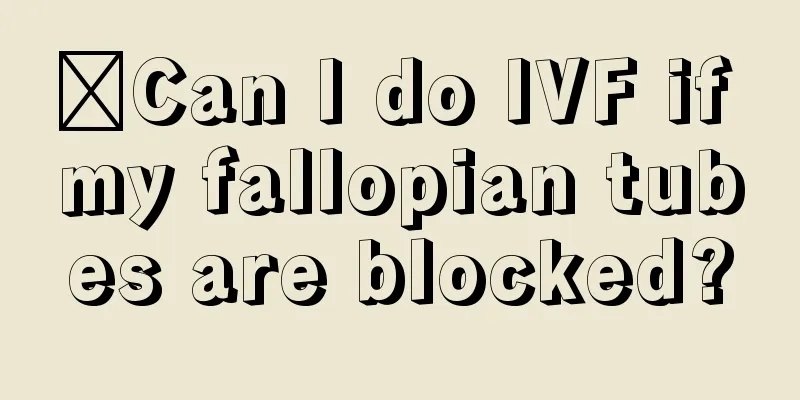Can I do IVF if my fallopian tubes are blocked?

|
When the first test-tube baby was born, many people were surprised. They were surprised that modern medical technology was so advanced that it greatly solved the practical difficulties of many infertile families. However, IVF also faces many problems, such as success rate, etc. Therefore, whether a couple should have IVF depends entirely on whether the conditions are met. So, can I do IVF if my fallopian tubes are blocked? Is it possible to ovulate after fallopian tube blockage? A sister once asked, "My fallopian tubes are blocked on both sides, why do you say I am ovulating?" We need to know that the fallopian tube and ovary are two independent organs, one is the passage and the other is the place of production. The ovary releases the egg, the fimbria of the fallopian tube picks up the egg, and through the movement of cilia, sends it to the ampulla of the fallopian tube for fertilization. If the fallopian tube is blocked, at most it will not be able to pick up eggs, but it will not affect the ovulation of the ovaries. It’s just that the egg can’t go to the fallopian tube or the uterus. Can the fallopian tubes be recanalized? First, we need to determine whether the blockage is at the proximal or distal end. The part close to the uterus is called the proximal end; the part at the other end of the umbrella that holds the egg is called the distal end. If the end of the fallopian tube is blocked, it may be due to water accumulation. You can use laparoscopy to cut open the area where the water is accumulated, remove the accumulated water, and then perform plastic surgery to restore the patency of the fallopian tube. The fallopian tube is about 8-12 cm long, and the lumen is very thin, as thin as the ball of a ballpoint pen. If there is water accumulation, the fallopian tube will often be stretched larger, sometimes even up to two centimeters in diameter, which means it has been severely deformed. How long will it take to get pregnant after re-canalization before trying IVF? If the pelvic adhesion is very severe, it is generally better to try for three or four months, because the chances are slim and there is little point in trying for too long. If the pelvic adhesion is not very serious and only the proximal blockage is present, you can try for about a year after recanalization. During this period, the doctor will arrange for ovulation induction, natural conception or artificial insemination. If you still cannot get pregnant, you can consider in vitro fertilization. Doctors generally recommend that sisters with pelvic adhesions try for about half a year after restoration of cannulation before considering IVF. |
<<: Will a tortuous fallopian tube affect pregnancy?
>>: What to do if both sides of the fallopian tube are blocked
Recommend
Three months pregnant vaginal itching
Pregnancy is definitely a period of hormonal diso...
Normal hcg values at 5 weeks of pregnancy
A woman's physical health during pregnancy ha...
What is the meaning of persimmon peanuts? How to ripen persimmons and remove their astringency
Persimmons are rich in nutritional value, contain...
Does drinking soy milk during menstruation increase breast size? The truth is this
Plump breasts and a golden ratio S-shaped figure ...
What are the traditional Chinese medicines for treating gynecological inflammation?
Gynecological diseases have always been a stubbor...
Caesarean section, 20 days after sex, she died
It is very bad for women to resume sexual life to...
How long does it take for menstruation to be normal after a miscarriage?
Generally, after a miscarriage, you will have nor...
How is breast melanoma treated?
It is very important to take care of the breasts....
What is whole milk? Which brand of whole milk is good?
Whole milk is milk that has been skimmed from raw...
How long does it take to get your period after wearing the ring?
Wearing an IUD is a common contraceptive method f...
The temperature dropped sharply, and the 70-year-old man insisted on morning exercise, and danger came
"He often didn't listen to my advice. He...
I have had an abortion for 11 days and the bleeding has increased
Medical abortion is a method of abortion that man...
Is it normal to have yellow discharge during early pregnancy?
Leucorrhea is colorless and transparent, and has ...
Diagnosis and treatment of female urinary incontinence
According to statistics, the probability of urina...
Is backache related to gynecological diseases?
Speaking of the problem of low back pain, I belie...









